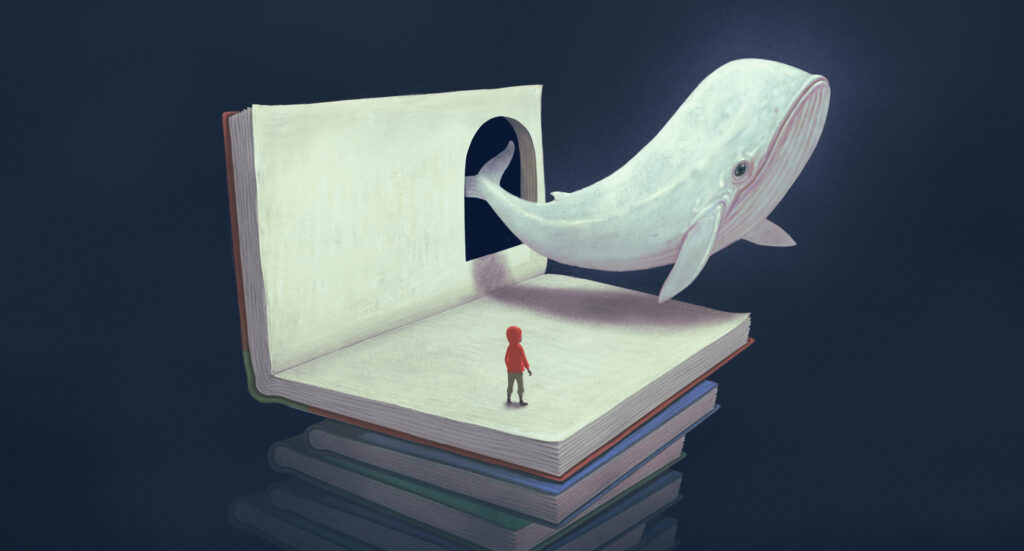When we visit an art exhibition, we often start with a pre-conceived set of ideas about what it will be like, which transforms over time as we experience it for ourselves, and the same is true for L&D.
If you pay a visit to the David Hockney exhibition at the Lightroom in Kings Cross London you are in for a treat. The display is not a collection of paintings but a series of projections on all four walls set inside a huge box that contains the audience but does not restrain them from walking around and exploring the whole environment – hence the name, ‘the Lightroom’. It’s a new experimental space and Hockney is the inaugural artist.
We tend to push organisations further away to make them smaller and more manageable – to get the whole picture, so to speak.
The exhibition comprises a continuous 50 minute narrative, repeated on a loop throughout the day, voiced by Hockey himself from comments and interviews given over 30 years. It covers all the major themes in Hockney’s work going back over his career, including his work on canvas with paint; his composite pictures made up of huge numbers of polaroid prints taken from different angles; his sketches on iPads, as well as his work with more orthodox materials including 35mm film. In addition there is a section on his set design work for the theatre and opera that was commissioned by major venues all over the world.
The impact of seeing an image projected to a height of seven metres on all four walls simultaneously is overwhelming. It forces you to look again at Hockney’s works and see them from an entirely different perspective, literally and metaphorically. Engaging and consuming those works ‘bigger and closer’ is like seeing them for the first time, and as a result, many new insights emerge. What works for Hockney could also work for L&D.
Confronting organisational culture
We tend to push organisations further away to make them smaller and more manageable – to get the whole picture, so to speak. The truth is that many of those who work in L&D would be better to experience the reality of work, and of working in their organisation from very close quarters to understand viscerally what the challenges staff face and therefore what interventions make a difference and help deliver high performance, and what the greatest barriers to high performance might be. You will never see that from afar, and you will never see it if you are not prepared to do the fieldwork and look up close.
Ubiquitous learning should be based on pinpoint relevance and deep understanding.
I would therefore challenge the idea that ubiquitous learning is simply piled up learning opportunities; rather like the way a supermarket piles tins of tomatoes and offers ten almost identical brands of tinned tomatoes to create the illusion of choice. Boasting about quantity or volume was never an acceptable stance in supermarkets or in L&D.
Relevance and understanding
When you’re looking for something special and individual, if you have to choose between a supermarket with stacked shelves and a small delicatessen with nothing but a few high quality items, you would always go for the small batch quality rather than the high batch availability.
Think it through: choose bigger and closer over smaller and further away every time.
When you are driving performance you need to have close up knowledge of what is required. Ubiquitous learning should be based on pinpoint relevance and deep understanding, not on generalised off-the-shelf commodities that are grabbed for their convenience rather than their efficacy – that only looks good from a distance.
Embracing discomfort
It’s important to think very carefully about what you mean by ubiquitous learning. It is certainly not learning everywhere; it is relevant learning, accessible at the point of need that contributes to high performance, and takes the learner one step closer to solving their own learning challenges. This is much more powerful than tying the learner into a dependency rather than a facilitating relationship with L&D.
Think it through: choose bigger and closer over smaller and further away every time, in spite of the discomfort that can bring in its wake. The reality of what is needed is always more complex than what you imagine from the outside looking in.
If you enjoyed this, read: Editor’s note: Seeing learning as ubiquitous in 2023.
When we visit an art exhibition, we often start with a pre-conceived set of ideas about what it will be like, which transforms over time as we experience it for ourselves, and the same is true for L&D.
If you pay a visit to the David Hockney exhibition at the Lightroom in Kings Cross London you are in for a treat. The display is not a collection of paintings but a series of projections on all four walls set inside a huge box that contains the audience but does not restrain them from walking around and exploring the whole environment - hence the name, ‘the Lightroom’. It’s a new experimental space and Hockney is the inaugural artist.
We tend to push organisations further away to make them smaller and more manageable - to get the whole picture, so to speak.
The exhibition comprises a continuous 50 minute narrative, repeated on a loop throughout the day, voiced by Hockey himself from comments and interviews given over 30 years. It covers all the major themes in Hockney’s work going back over his career, including his work on canvas with paint; his composite pictures made up of huge numbers of polaroid prints taken from different angles; his sketches on iPads, as well as his work with more orthodox materials including 35mm film. In addition there is a section on his set design work for the theatre and opera that was commissioned by major venues all over the world.
The impact of seeing an image projected to a height of seven metres on all four walls simultaneously is overwhelming. It forces you to look again at Hockney’s works and see them from an entirely different perspective, literally and metaphorically. Engaging and consuming those works ‘bigger and closer’ is like seeing them for the first time, and as a result, many new insights emerge. What works for Hockney could also work for L&D.
Confronting organisational culture
We tend to push organisations further away to make them smaller and more manageable - to get the whole picture, so to speak. The truth is that many of those who work in L&D would be better to experience the reality of work, and of working in their organisation from very close quarters to understand viscerally what the challenges staff face and therefore what interventions make a difference and help deliver high performance, and what the greatest barriers to high performance might be. You will never see that from afar, and you will never see it if you are not prepared to do the fieldwork and look up close.
Ubiquitous learning should be based on pinpoint relevance and deep understanding.
I would therefore challenge the idea that ubiquitous learning is simply piled up learning opportunities; rather like the way a supermarket piles tins of tomatoes and offers ten almost identical brands of tinned tomatoes to create the illusion of choice. Boasting about quantity or volume was never an acceptable stance in supermarkets or in L&D.
Relevance and understanding
When you’re looking for something special and individual, if you have to choose between a supermarket with stacked shelves and a small delicatessen with nothing but a few high quality items, you would always go for the small batch quality rather than the high batch availability.
Think it through: choose bigger and closer over smaller and further away every time.
When you are driving performance you need to have close up knowledge of what is required. Ubiquitous learning should be based on pinpoint relevance and deep understanding, not on generalised off-the-shelf commodities that are grabbed for their convenience rather than their efficacy - that only looks good from a distance.
Embracing discomfort
It’s important to think very carefully about what you mean by ubiquitous learning. It is certainly not learning everywhere; it is relevant learning, accessible at the point of need that contributes to high performance, and takes the learner one step closer to solving their own learning challenges. This is much more powerful than tying the learner into a dependency rather than a facilitating relationship with L&D.
Think it through: choose bigger and closer over smaller and further away every time, in spite of the discomfort that can bring in its wake. The reality of what is needed is always more complex than what you imagine from the outside looking in.
If you enjoyed this, read: Editor’s note: Seeing learning as ubiquitous in 2023.





